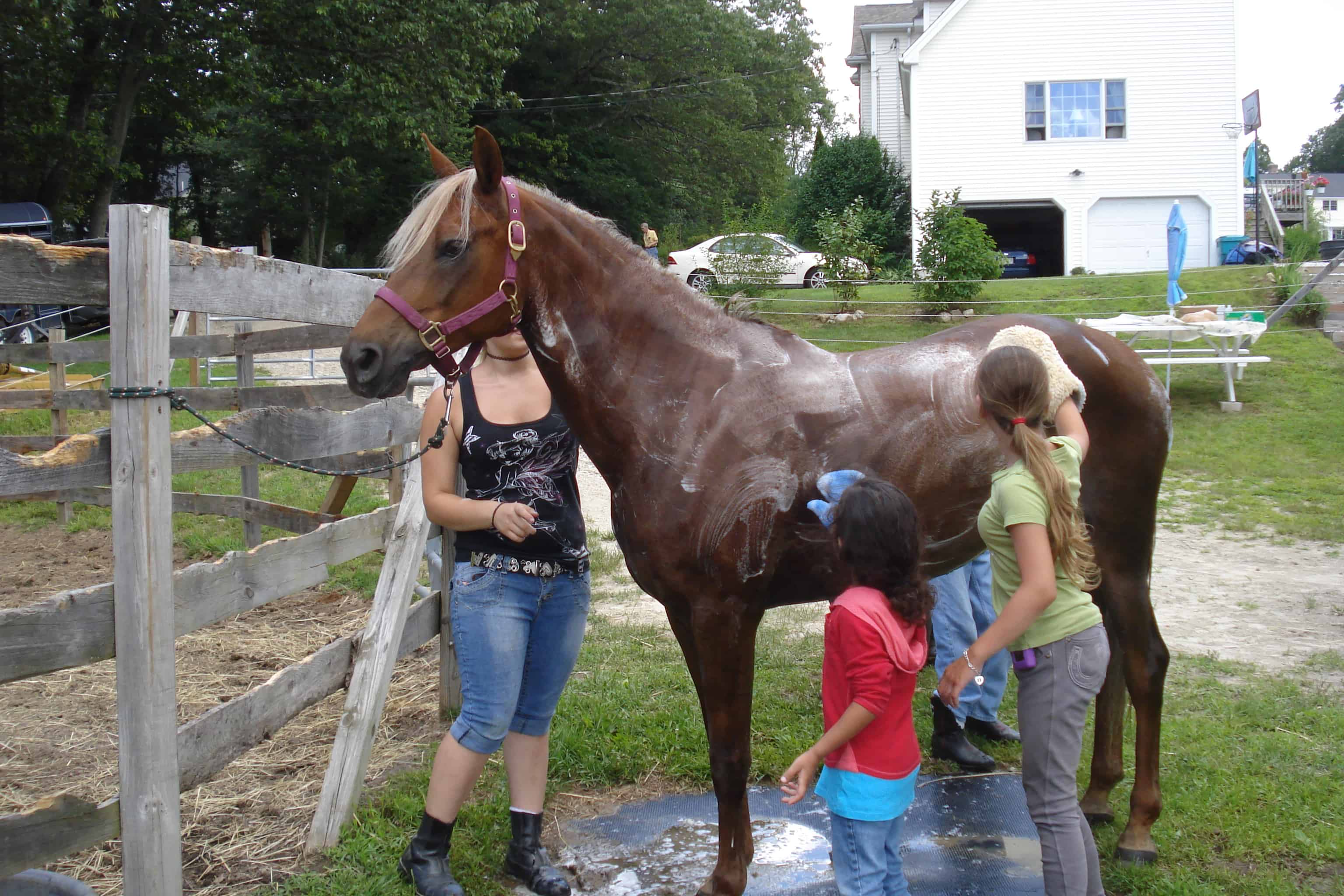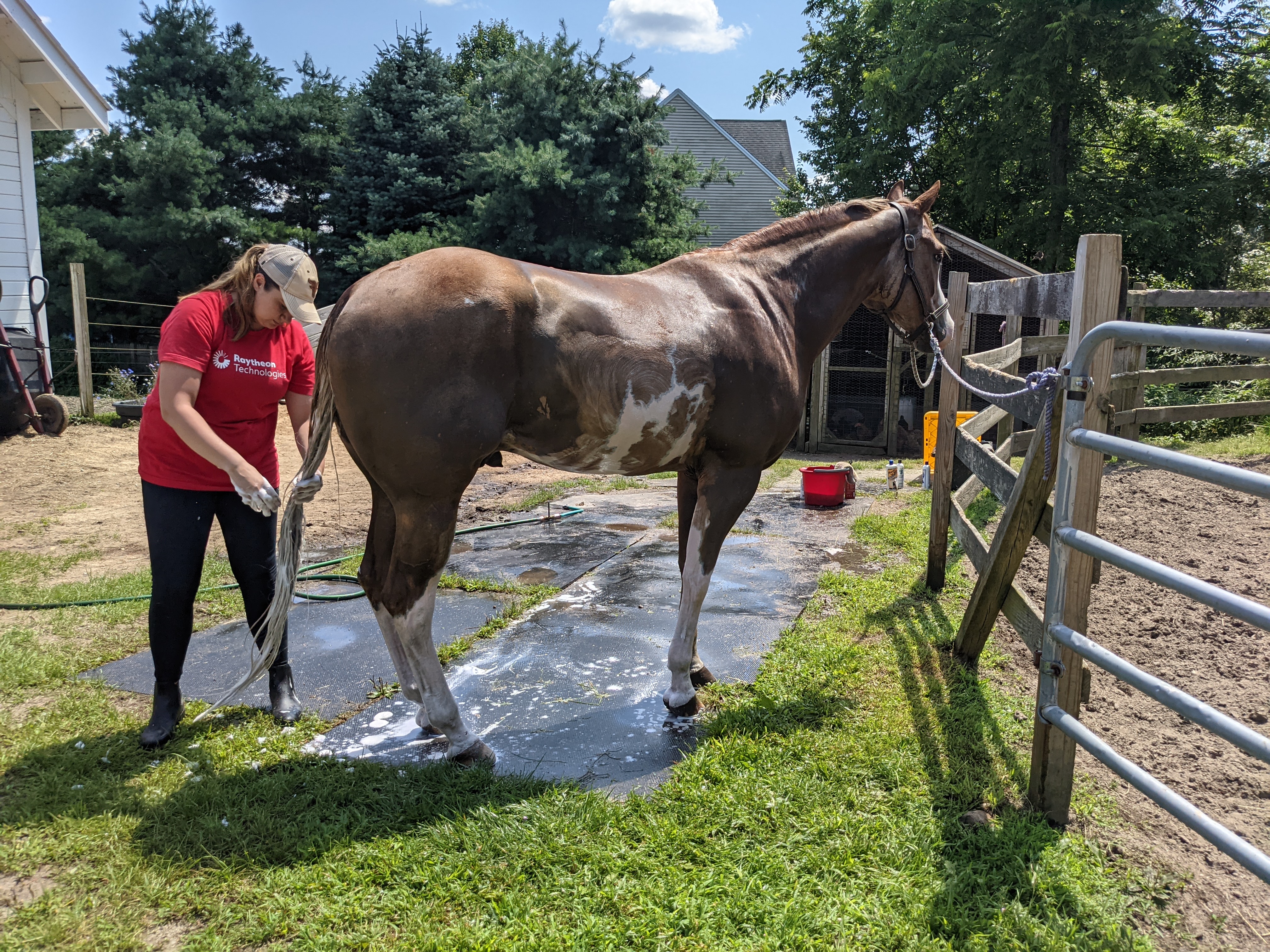Spring is just around the corner! Yay! For equestrians that means we are getting antsy and ready to shed out and wash our horses! Your horse’s tail may be full of mud, manure and tangles thanks to the cold winter unless you are lucky enough to have a barn with warm water and an indoor wash stall. Here are my tips for getting your horse’s tail sparkling clean whether for a horse show or just to get the winter grime out!
And, if spring has you pumped about getting your horse shiny after a long winter, check out my review of the StripHair Gentle Groomer For Horses and my complete beginner’s guide to bathing your horse!
And, just a quick note about safety. This article assumes your horse is not afraid of the hose or water and knows how to stand tied safely. If this is not the case, you need to start by getting some help from your instructor and teaching your horse how to tie and get them used to the water.
What You’ll Need
The supplies you’ll need for washing your horse’s tail are pretty straight forward. The process is similar to washing your own hair and so are the supplies.
- Shampoo
- Bluing Shampoo For Light Colors (Optional)
- Conditioner
- Hose or Bucket
- Halter
- Safe Place To Tie Your Horse or Helper
- Brush (Optional)
- Detangle Spray
This post may contain affiliate links which means that I may earn a small commission at no extra cost to you. As an Amazon Associate I earn from qualifying purchases.
Here are some products I use on my horses and recommend.





Wet Thoroughly
The first step to getting your horse’s tail squeaky clean it to wet it thoroughly. In order for the shampoo to lather and effectively clean your horse’s tail, you need to get the tail as saturated with water as possible.
Additionally, you’ll want to rinse out as much dirt, manure and urine out of your horse’s tail as possible before you start applying any products.
Shampoo
Once your horse’s tail is completely soaking wet, it’s time to start shampooing. Start by applying shampoo with your hands on the dock of the tail and scrub the tail bone clean. Just like you would scrub your own scalp when washing your hair.
Check for tick residue while you’re scrubbing. If your horse’s tail is not very dirty, don’t wash the lower portion of the tail with the shampoo.
Excess shampooing can dry out the hair and make it brittle. If your horse is having their first bath after winter or the tail is really dirty you can apply shampoo to the lower half of the tail.
Otherwise, when you rinse the tail, the shampoo will run through the hair as the water flows through. Depending on how dirty your horse’s tail is, you may need to rinse and re-apply shampoo again.
Do not try to detangle your horse’s tail during the shampooing process as you risk breaking some of the hairs or pulling them out.
Rinse Thoroughly
Once your horse’s tail has been scrubbed clean it’s important to thoroughly rinse out all of the shampoo. You don’t want product residue to build up on your horse’s tail bone making your horse’s tail sticky and dirty.
As your rinse the tail, run your hand down the length of the tail to help squeeze out the excess water. Keep rinsing until the water running off your horse’s tail is clear and has no suds. Once there is no evidence of dirt or shampoo your horse’s tail you can move on to the next step.
Apply Conditioner
The next step is to apply conditioner. You may be tempted to just start detangling, but don’t! The next couple of steps take a bit of patience. Apply conditioner to the lower portion of your horse’s tail below the tail bone. Don’t apply conditioner onto the dock. As you apply the conditioner squish the hair a few times and if you don’t hear a squishing sound, add water.
You may notice that even though you rinsed your horse’s tail to get the shampoo out, as you are applying conditioner the tail doesn’t feel saturated with enough water. In order for the conditioner to help the knots fall out by themselves the tail needs to be very wet. This is a tip I learned from watching YouTube videos about taking care of curly (human) hair.
Once you have applied a generous amount of conditioner and squished it through the hair, it’s time to move on.
Let Sit
This is the part that takes patience. Let the conditioner sit for a couple of minutes.
There is no set amount of time for this step. However, I notice a huge difference in the amount of effort it takes to detangle the horse’s tail when I do not let the conditioner sit for a while. We’re only talking about 5 minutes. If you leave it longer, the hair may start to dry.
What I typically do is wash my horse and shampoo and condition the tail. Then, while the conditioner is sitting, I wash my horse’s white legs with bluing shampoo and give them a good scrub.
Detangle Gently
Once the conditioner has been allowed to sit in the tail for a couple of minutes, it’s time to detangle. If the tail as started to dry while the conditioner was sitting, add a small amount of water.
Gently work through the knots with your FINGERS! Do not take out your tail brush yet! Work from the outside of the tangles and gently pull the outer pieces away from the knot and work your way inward. If there are no obvious knots you can split your horse’s tail in half. Then start to separate small sections about a half inch at a time. As you go you will find tangles.
Once you’ve worked your way through the whole tail give it one last check to see if you missed any tangles.

Rinse Thoroughly
Now that you’ve slowly and methodically conditioned your horse’s tail, it’s time to give it another good rinse. And, as I mentioned above you’ll want to rinse out all of the conditioner thoroughly. Once again, let the water run until it is clean and clear.
Apply Detangle Spray & Brush
At this point, it is safe to apply your favorite detangle spray or show sheen to the tail.
You can also very gently brush out the tail starting from the bottom so as not to pull on any tangles you may have missed.
If you want to avoid ripping out any hair or breaking any hair in your horse’s tail, save the brushing until after you have detangled with conditioner.
Brushing dirty hair or using a tail brush before detangling the hair with your fingers is a quick way to thin out your horse’s tail. Trust me, you’ll regret it!
My horses tend to get slightly thinner tails in the summer due to swatting at flies so when they recover over the winter and get their normal length and thickness back I like to savor it for as long as possible.
Safety Tips For Tail Washing
As I mentioned above, these tips are for horses that are well accustomed to getting bathed and having their tails washed. If your horse is young, green, anxious or kicks, you need to get help from an experienced handler to avoid getting hurt.
If your horse does not tie but is ok with water, have someone hold the horse instead of tying him.
Also, do NOT stand directly behind the horse. Yes, I know you need to reach the tail to clean it. But, stand to the side and close to the horse. You’ll be able to reach and you bring the tail over towards you to detangle the hair.
Even if your horse is an old pro, many horses have sensitive tail bones. If you have not bathed your horse and are just washing his tail, don’t just start blasting cold water onto the top of the tail.
Start by spraying the water down near your horse’s back feet and wet the bottom of the tail. Work your way up to the top and continue to rinse until the tail is wet. This is the best way to avoid startling your horse or making him inadvertently kick out due to the cold water.
I hope you’ve found this article helpful! If you did, please share!

